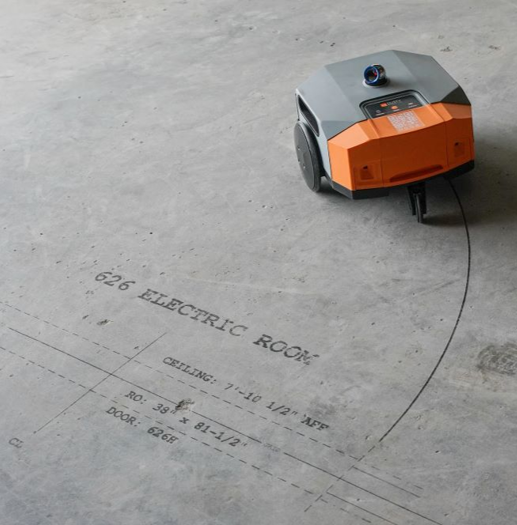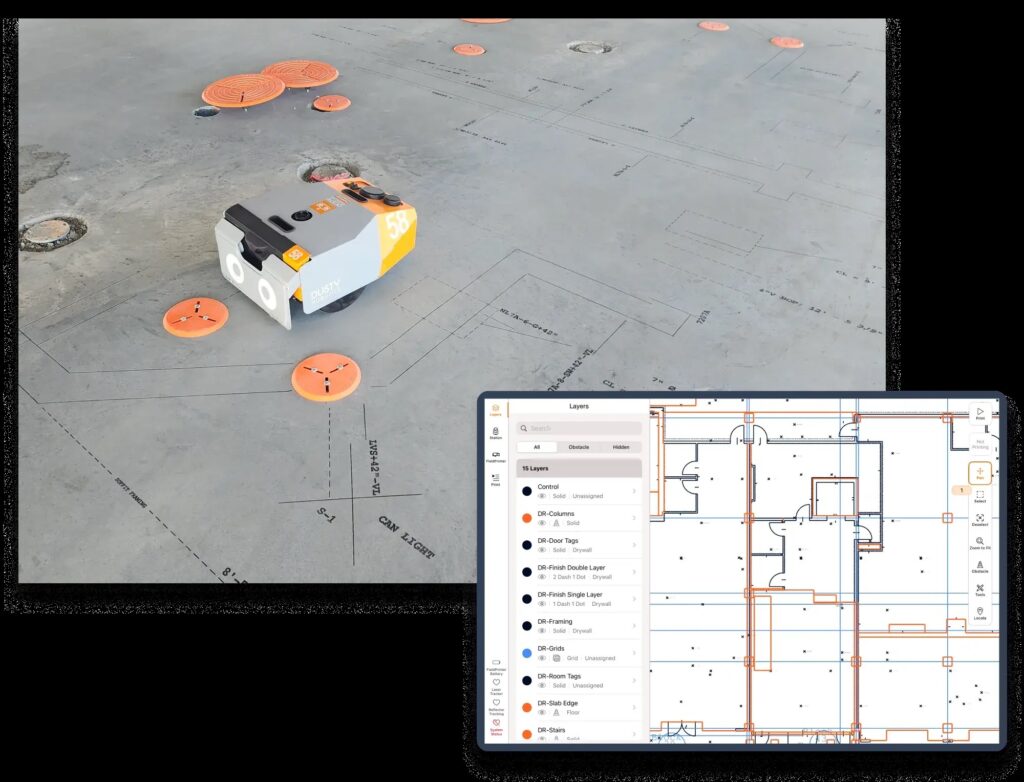CASE STUDY: DUSTY ROBOTICS
Print Module Design for a Construction Slab Printing Robot
THE CHALLENGE
In construction, layout is the process of taking a building’s 2D CAD drawing and transferring it to the floor so that subsequent workers can put in walls, plumbing, electrical, and other features. Traditionally, this is a very manual and error-prone process that is often performed by the foreman.
Dusty Robotics had the idea to use a robot to improve collaboration on the jobsite by directly printing construction drawings for all the trades at once, including framing, mechanical, electrical, and others on the slab with an accuracy of 1/16-inch in all dimensions. The robot had to be capable of operating in the complex real world of large construction sites. When Dusty Robotics sought to upgrade their printhead controller to handle custom, high-precision lines, text, and characters, they selected Simplexity to develop their next-generation printing module.
Mike Thompson, Principal Engineer at Dusty Robotics, explained that “At Dusty, we are expert robot builders who pioneered a new class of robots for automated construction layout in the construction industry. While we lead the way in developing cutting-edge construction robotics, we partnered with the industry experts at Simplexity to incorporate their decades of specialized knowledge with inkjet printing into a custom solution tailored to our customers’ unique requirements.”
SYSTEMS APPROACH
As in any multidisciplinary development program, systems engineering was involved from the start. One of the challenges facing the Dusty Robotics / Simplexity team was that Dusty Robotics wanted to try different printing technologies for construction sites. Since the original architecture did not have the flexibility to drive complex interfaces for different printheads, Simplexity developed a flexible drive architecture using a field-programmable gate array (FPGA).
ELECTRICAL ENGINEERING
To minimize prototype development time and cost, Simplexity worked initially with two off-the-shelf development boards:
- One printed circuit board (PCB) to drive the printhead technologies
- Another PCB to receive the ink pattern
After proving the concept worked using the off-the-shelf boards, Simplexity designed and built a custom print module PCA. Specific tasks included schematic capture, layout, fabrication support, bring-up, and testing on the simplified robot. Once the PCA passed all the required tests, it was installed in the Dusty Robotics FieldPrinter 1 for use on the construction floor.
FIRMWARE ENGINEERING
On this project, “firmware” consists of the embedded software running a microcontroller (MCU) plus the hardware description language specifying the behavior of the two print system FPGAs. Dusty Robotics used their own engineering leadership for the overall embedded software solution, while Simplexity was responsible for the print system’s FPGA logic.
NEXT GENERATION ROBOT
Once testing with the first robot was complete, Dusty Robotics approached Simplexity for help with the next generation of the robot. This was to incorporate what had been learned from the previous generation and add new features. Dusty’s engineering team leveraged Simplexity’s expertise for a new revision of the print board, design of new boards, and to provide review and design for manufacturing (DFM) input for boards that Dusty Robotics was designing in-house.
Thompson added, “By combining Dusty’s innovative engineering with targeted expertise from trusted partners like Simplexity, we’ve set the standard for layout quality and accuracy in the construction industry, and are continuing to push forward what’s possible with automated layout quality and speed.”

THE RESULTS
Dusty Robotics’ next-generation robots have been deployed to multiple construction sites as the company demonstrates its technology for producing accurate and speedy layout. The Dusty Robotics FieldPrint Platform has completed well over 100 million square feet of production layout. Dusty is trusted by leading general contractors such as Mortenson, McCarthy, and Skanska as well as trade contractors in framing, mechanical, electrical, and plumbing.


